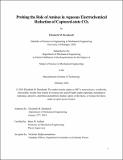| dc.description.abstract | Integrating CO₂ capture and CO₂ conversion into a single reactor presents an opportunity to power the combined process with renewable electricity. The integration of these two historically separate technologies establishes a large system parameter space, which introduces many handles for system optimization, but also presents many challenges. As the capture medium takes on the dual role of sorbent and electrolyte, a complex landscape of potential reaction pathways emerges. Before these integrated systems can be engineered to perform at industrial scales, we must better understand the speciation and characteristics of the capture medium, as well as its impact on transport and interfacial properties. The integration of CO₂ capture and conversion processes has primarily been investigated in aqueous, amine-based solutions to draw on the maturity of amine chemistry in CO₂ capture. However, when subjected to reducing currents, the aqueous solvent provides a pathway for parasitic hydrogen evolution. Additionally, amines become ion pairs upon uptake of CO₂, giving them the opportunity to act as both reactant and supporting electrolyte. We approach the complexity of these systems by investigating the influence of amine choice on electrochemical performance. Primarily, we explore how amine physicochemical properties, namely steric hindrance and pKₐ, impact speciation, product selectivity, and cell performance. We chose a subset of primary alkylamines with varied steric hindrance and pKₐ and evaluated each on the basis of Faradaic efficiency, partial current density to reduced products, and the dynamics of product formation on Ag-based electrocatalysts. Through these measurements, we elucidate trends in the competition of hydrogen evolution and carbon monoxide formation as a function of amine pKₐ and steric hindrance in order to inform the choice of sorbent-electrolyte for industrially integrated amine-based CO₂ capture and conversion. | |
